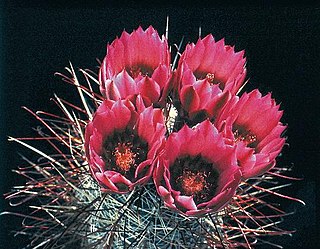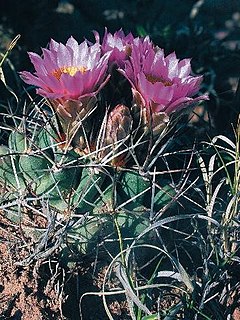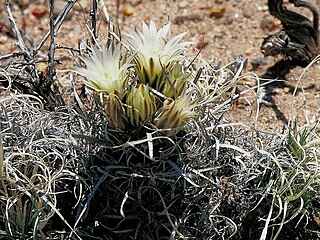
Canyonlands National Park is an American national park located in southeastern Utah near the town of Moab. The park preserves a colorful landscape eroded into numerous canyons, mesas, and buttes by the Colorado River, the Green River, and their respective tributaries. Legislation creating the park was signed into law by President Lyndon Johnson on September 12, 1964.

Ferocactus is a genus of large barrel-shaped cacti, mostly with large spines and small flowers. There are about 30 species included in the genus. They are found in the southwestern United States and northwestern Mexico.

Sclerocactus is a genus of cacti. It comprises about 15 species, the exact number depending on the authority. These species are very xerophytic. They are sometimes called 'fishhook cactus' or 'little barrels.'

The Cactoideae are the largest subfamily of the cactus family, Cactaceae. Around 80% of cactus species belong to this subfamily. As of August 2018, the internal classification of the family Cactaceae remained uncertain and subject to change. A classification incorporating many of the insights from the molecular studies was produced by Nyffeler and Eggli in 2010.

Fishhook cactus is a common name for any hook-spined species of the genera Mammillaria, Echinomastus or Sclerocactus. They are small cacti, usually growing up to 6-7 inches (20 cm) high, and are shaped similar to a barrel cactus. They are not to be confused with the fishhook barrel cactus of the Sonoran and Chihuahuan Deserts. The Fishhook cactus is a large category of around 150 species.

Echinomastus johnsonii is a species of cactus known by the common names Johnson's beehive cactus and Johnson's fishhook cactus. It is native to the southwestern United States from eastern California to Utah, where it can be found in desert scrub habitat. It produces an egg-shaped or cylindrical stem up to 25 centimetres tall by 10 centimetres wide. It is covered densely in straight and curving spines which may be up to 4 centimetres long and come in shades of yellow, gray, lavender, and pink or red, with up to 24 per areole. The cactus may have yellow or pink flowers; the species is sometimes divided into two varieties on the basis of flower color. Flowers are up to 8 centimetres wide. The scaly, fleshy fruit is up to 1.8 centimetres long.

Sclerocactus polyancistrus is a species of cactus known by several common names, including redspined fishhook cactus, Mojave fishhook cactus, pineapple cactus, and hermit cactus.

Sclerocactus brevihamatus is a species of cactus known by the common name shorthook fishhook cactus.

Sclerocactus mesae-verde, Mesa Verde cactus or Mesa Verde fishhook cactus, is a species of cactus in the Sclerocactus genus occurring in habitat at 4000–5000 ft. only in Colorado and New Mexico in the Four Corners region, United States. This species was discovered near Cortez and Mesa Verde by Charles H. Boissevain, and is the only known population group in Colorado. Sclerocactus mesae-verde was formerly classified in the monotypic genus Coloradoa.

Pediocactus sileri is a rare species of cactus known by the common names Siler's pincushion cactus and gypsum cactus. It is native to southwestern Utah and northwestern Arizona in the United States. It is limited to a specific type of soil, individuals are often spaced far apart, and the species is threatened by a number of human activities such as off-road vehicle use, poaching, and uranium mining. This is a federally listed threatened species of the United States.

Sclerocactus brevispinus is a rare species of cactus known by the common name Pariette cactus. It is endemic to Utah in the United States, where it is known only from the Pariette Draw, a draw in Duchesne County. It is threatened by a number of processes and human activities.

Sclerocactus glaucus is a rare species of cactus known by the common name Colorado hookless cactus. It is endemic to Colorado in the United States, where it is known only from the area between Grand Junction and Montrose. It is a federally listed threatened species.

Sclerocactus wetlandicus is a rare species of cactus known by the common name Uinta Basin hookless cactus. It is endemic to Utah in the United States, where it is known only from the Uinta Basin. It may also be called the Pariette cactus, but this name is more appropriate for Sclerocactus brevispinus, the species endemic to the Pariette Draw of Duchesne County.

Sclerocactus wrightiae is a rare species of cactus known by the common names Wright's little barrel cactus and Wright's fishhook cactus.

Sclerocactus papyracanthus is a species of cactus known by the common names paperspine fishhook cactus, grama grass cactus, paper-spined cactus, and toumeya. It is native to North America, where it occurs from Arizona to New Mexico to Texas and into Chihuahua, Northeastern Mexico.
Yosemitia graciella is a species of snout moth in the genus Yosemitia. It was described by George Duryea Hulst in 1887. It is found in the US states of Arizona, California, Nevada, Colorado, New Mexico and Texas.

Sclerocactus sileri, the Siler fishhook cactus, is a rare and very small cactus found mostly in mineral-rich desert areas of intermediate elevations, notably in the American states of Utah, Nevada, and northern Arizona.
Moneilema semipunctatum is a species of beetle in the family Cerambycidae. It was described by John Lawrence LeConte in 1852. It is known commonly as the cactus borer beetle. Beetles of genus Moneilema are known commonly as cactus longhorn beetles. It is native to North America, where it occurs in the western United States and Mexico.

Cylindropuntia whipplei is a member of the cactus family, Cactaceae.

Sclerocactus mesae-verdae, the Mesa Verde fishhook cactus, is a species of cactus native to northwestern New Mexico and southwestern Colorado. It is rare and listed as federally endangered.

















